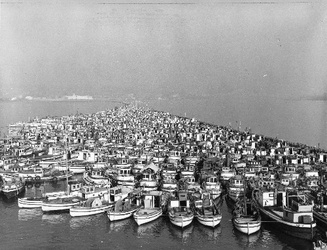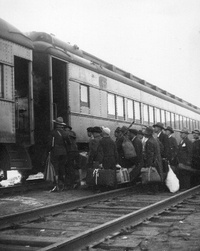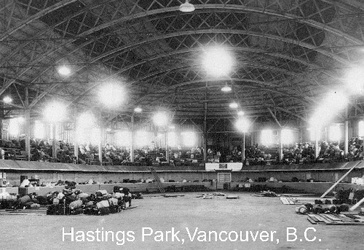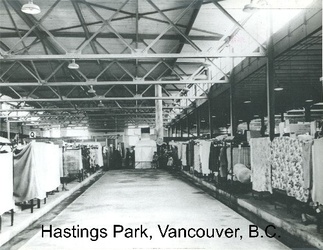1942 - The Canadian Government's Policies of Mass Evacuation, Internment and Expropriation of Property

|
||
| Licensing | ||
Contributed by the Japanese Canadian Cultural Centre.
Slides in this album |
|
|
|
IntroductionClick the icon to read the introductory text.
1942 - The Canadian Government's Policies of Mass Evacuation, Internment and Expropriation of Property |

|
Confiscated fishing boats - 1941, Vancouver, B.C.December 7, 1941 was the beginning of a nightmare for those of Japanese heritage along Canada’s Pacific Coast. One of the first acts of the federal government after Pearl Harbor was to impound the Japanese Canadian fishing fleet numbering a thousand boats.
Confiscated fishing boats - 1941, Vancouver, B.C. |

|
Handing in the car keys - 1941, Hastings Park, Vancouver, B.C.After the Pearl Harbor invasion in Dec. 7 1941, the Nikkei along the British Columbia coastal area were subjected to a succession of orders and ordinances that throttled the Nikkei activities and movements.
Handing in the car keys - 1941, Hastings Park, Vancouver, B.C. |

|
Men leaving for Road Camps - 1941, Vancouver, B.C.With pressure from the British Columbia lobbyists, the federal government implemented a protective zone of a hundred mile band of the British Columbia Pacific shore together with the islands. This area was to be vacated by male Japanese nationals of military age (18 to 45) by April 1, 1942. About …
Men leaving for road camps - 1941, Vancouver, B.C. |

|
Assembly Centre - 1941, Pacific National Exhibition, Hastings Park, Vancouver, B.C.Starting in January 1942, under the War Measures Act the Canadian Government declared the removal of “all persons of Japanese racial origin” from a 100 mile protected zone along the British Columbia Pacific coastline.
Assembly Centre - 1941, Pacific National Exhibition, Hastings Park, Vancouver, B.C. |

|
Assembly Centre - 1942, Women's dormitory, Hastings Park, Vancouver, B.C.As the evacuation of the Japanese continued and since the men were shipped to road camps or the POW camps, the women, children and elderly were herded to the livestock buildings of the Pacific National Exhibition in Hasting Park. The conditions were horrific. The building had not been properly cleaned …
Assembly Centre - 1942, Women's dormitory, Hastings Park, Vancouver, B.C. |

|
Assembly Centre - 1942, Communal laundry area, Hastings Park, Vancouver, B.C.A large communal washing area was set up for the Japanese who were held in the buildings at the Exhibition grounds at Hasting park, Vancouver, B.C. since it was to be a temporary holding area, the facilities were simple and large to accommodate the residents.
Assembly Centre - 1942, Communal laundry area, Hastings Park, Vancouver, B.C. |
 JCCC
JCCC
 Events at the JCCC
Events at the JCCC Life in the Canadian Internment and POW Camps
Life in the Canadian Internment and POW Camps 1942 - The Canadian Government's Policies of Mass Evacuation, Internment and Expropriation of Property
1942 - The Canadian Government's Policies of Mass Evacuation, Internment and Expropriation of Property The Nikkei in Pre-War British Columbia
The Nikkei in Pre-War British Columbia
 Journal feed
Journal feed
